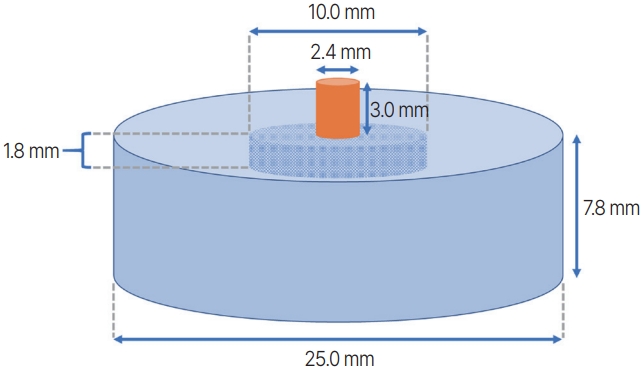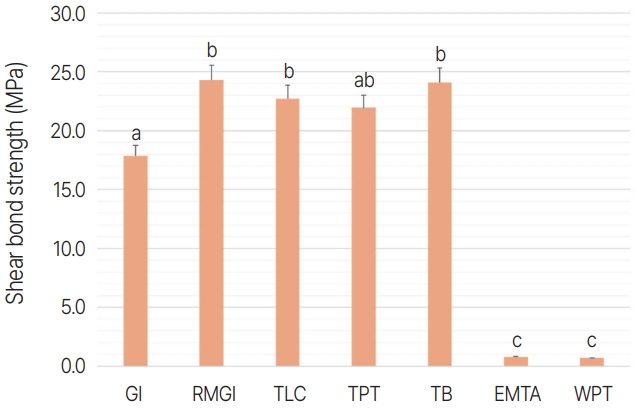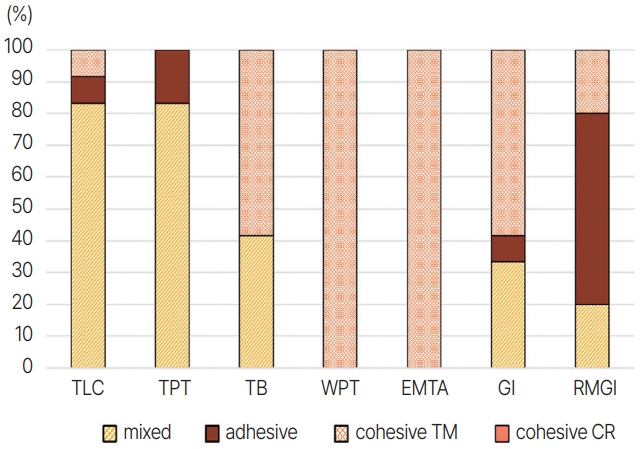1. American Academy of Pediatric Dentistry : Pulp therapy for primary and immature permanent teeth. The reference manual of pediatric dentistry. American Academy of Pediatric Dentistry, Chicago, 415-423, 2022.
2. Fuks AB : Vital pulp therapy with new materials for primary teeth: new directions and treatment perspectives.
J Endod, 34(7 Suppl):S18-S24, 2008.


3. Gruythuysen RJ, van Strijp AJ, Wu MK : Long-term survival of indirect pulp treatment performed in primary and permanent teeth with clinically diagnosed deep carious lesions.
J Endod, 36:1490-1493, 2010.


4. Akhlaghi N, Khademi A : Outcomes of vital pulp therapy in permanent teeth with different medicaments based on review of the literature.
Dent Res J (Isfahan), 12:406-417, 2015.



5. Kunert M, Lukomska-Szymanska M : Bio-inductive materials in direct and indirect pulp capping: a review article.
Materials (Basel), 13:1204, 2020.



6. Witherspoon DE : Vital pulp therapy with new materials: new directions and treatment perspectives - permanent teeth.
Pediatr Dent, 30:220-224, 2008.


7. Camilleri J, Montesin FE, Curtis RV, Ford TRP : Characterization of Portland cement for use as a dental restorative material.
Dent Mater, 22:569-575, 2006.


9. Choi Y, Park SJ, Lee SH, Hwang YC, Yu MK, Min KS : Biological effects and washout resistance of a newly developed fast-setting pozzolan cement.
J Endod, 39:467-472, 2013.


10. Rahman B, Goswami M : Comparative evaluation of indirect pulp therapy in young permanent teeth using Biodentine and TheraCal: a randomized clinical trial.
J Clin Pediatr Dent, 45:158-164, 2021.



11. Sharma A, Thomas MS, Shetty N, Srikant N : Evaluation of indirect pulp capping using pozzolan-based cement (Endocem MTA Zr) and mineral trioxide aggregate - A randomized controlled trial.
J Conserv Dent, 23:152-157, 2020.



12. Deepa VL, Dhamaraju B, Bollu IP, Balaji TS : Shear bond strength evaluation of resin composite bonded to three different liners: TheraCal LC, Biodentine, and resin-modified glass ionomer cement using universal adhesive: An in vitro study.
J Conserv Dent, 19:166-170, 2016.



13. Singla MG, Wahi P : Comparative evaluation of shear bond strength of Biodentine, Endocem mineral trioxide aggregate, and TheraCal LC to resin composite using a universal adhesive: An in vitro study.
Endodontology, 32:14-19, 2020.

14. Alhowaish L, Salama F, Al-Harbi M, Abumoatti M : Shear bond strength of a resin composite to six pulp capping materials used in primary teeth.
J Clin Pediatr Dent, 44:234-239, 2020.



15. Rodríguez-Lozano FJ, López-García S, García-Bernal D, Sanz JL, Lozano A, Pecci-Lloret MP, Melo M, López-Ginés C, Forner L : Cytocompatibility and bioactive properties of the new dual-curing resin-modified calcium silicate-based material for vital pulp therapy.
Clin Oral Investig, 25:5009-5024, 2021.



16. Sanz JL, Soler-Doria A, López-García S, García-Bernal D, Rodríguez-Lozano FJ, Lozano A, Llena C, Forner L, Guerrero-Gironés J, Melo M : Comparative biological properties and mineralization potential of 3 endodontic materials for vital pulp therapy: TheraCal PT, TheraCal LC, and Biodentine on human dental pulp stem cells.
J Endod, 47:1896-1906, 2021.


17. Kim M, Lee SH, Shin DH : In vitro study of the biological and physical properties of dual-cure resin-modified calcium silicate-based cement.
Dent J (Basel), 11:120, 2023.



18. Hebling J, Lessa FC, Nogueira I, Carvalho RM, Costa CA : Cytotoxicity of resin-based light-cured liners.
Am J Dent, 22:137-142, 2009.

19. Wassel M, Hamdy D, Elghazawy R : Evaluation of four vital pulp therapies for primary molars using a dual-cured tricalcium silicate (TheraCal PT): one-year results of a non-randomized clinical trial.
J Clin Pediatr Dent, 47:10-22, 2023.

20. Jang E, Lee J, Nam S, Kwon T, Kim H : Comparison of microleakage and compressive strength of different base materials.
J Korean Acad Pediatr Dent, 48:168-175, 2021.

21. Fujiwara S, Takamizawa T, Barkmeier WW, Tsujimoto A, Imai A, Watanabe H, Erickson RL, Latta MA, Nakatsuka T, Miyazaki M : Effect of double-layer application on bond quality of adhesive systems.
J Mech Behav Biomed Mater, 77:501-509, 2018.


22. Triolo Jr Jr PT, Swift Jr Jr EJ, Barkmeier WW : Shear bond strengths of composite to dentin using six dental adhesive systems.
Oper Dent, 20:46-50, 1995.

23. Hashem DF, Foxton R, Manoharan A, Watson TF, Banerjee A : The physical characteristics of resin composite-calcium silicate interface as part of a layered/laminate adhesive restoration.
Dent Mater, 30:343-349, 2014.


25. Bachoo IK, Seymour D, Brunton P : A biocompatible and bioactive replacement for dentine: is this a reality? The properties and uses of a novel calcium-based cement.
Br Dent J, 214:E5, 2013.



26. Che JL, Kim JH, Kim SM, Choi NK, Moon HJ, Hwang MJ, Song HJ, Park YJ : Comparison of setting time, compressive strength, solubility, and pH of four kinds of MTA.
Korean J Dent Mater, 43:61-72, 2016.

27. Palma PJ, Marques JA, Falacho RI, Vinagre A, Santos JM, Ramos JC : Does delayed restoration improve shear bond strength of different restorative protocols to calcium silicate-based cements?
Materials (Basel), 11:2216, 2018.



28. Hursh KA, Kirkpatrick TC, Cardon JW, Brewster JA, Black SW, Himel VT, Sabey KA : Shear bond comparison between 4 bioceramic materials and dual-cure composite resin.
J Endod, 45:1378-1383, 2019.


29. Alqahtani AS, Sulimany AM, Alayad AS, Alqahtani AS, Bawazir OA : Evaluation of the shear bond strength of four bioceramic materials with different restorative materials and timings.
Materials (Basel), 15:4668, 2022.



30. Schmidt A, Schäfer E, Dammaschke T : Shear bond strength of lining materials to calcium-silicate cements at different time intervals.
J Adhes Dent, 19:129-135, 2017.

32. Sarkar NK, Caicedo R, Ritwik P, Moiseyeva R, Kawashima I : Physicochemical basis of the biologic properties of mineral trioxide aggregate.
J Endod, 31:97-100, 2005.


33. Back S, Jang Y, Lee J, Lee J, Shin J, Kim J, Han M, Kim J : pH, ion release capability, and solubility value of premixed mineral trioxide aggregates.
J Korean Acad Pediatr Dent, 49:379-391, 2022.


34. Jang Y, Kim Y, Lee J, Kim J, Lee J, Han MR, Kim J, Shin J : Evaluation of setting time, solubility, and compressive strength of four calcium silicate-based cements.
J Korean Acad Pediatr Dent, 50:217-228, 2023.


35. Bayrak S, Tunç ES, Saroğlu I, Eğilmez T : Shear bond strengths of different adhesive systems to white mineral trioxide aggregate.
Dent Mater J, 28:62-67, 2009.


36. Tunç ES, Sönmez IS, Bayrak S, Eğilmez T : The evaluation of bond strength of a composite and a compomer to white mineral trioxide aggregate with two different bonding systems.
J Endod, 34:603-605, 2008.


37. Neelakantan P, Grotra D, Subbarao CV, Garcia-Godoy F : The shear bond strength of resin-based composite to white mineral trioxide aggregate.
J Am Dent Assoc, 143:E40-E45, 2012.


38. Shin JH, Jang JH, Park SH, Kim E : Effect of mineral trioxide aggregate surface treatments on morphology and bond strength to composite resin.
J Endod, 40:1210-1216, 2014.


39. Shin H, Kim M, Nam O, Lee H, Choi S, Kim K : Shear bond strength comparison of different adhesive systems to calcium silicate-based materials.
J Korean Acad Pediatr Dent, 45:445-454, 2018.

40. Alzraikat H, Taha NA, Qasrawi D, Burrow MF : Shear bond strength of a novel light-cured calcium silicate-based cement to resin composite using different adhesive systems.
Dent Mater J, 35:881-887, 2016.


41. Karadas M, Cantekin K, Gumus H, Ateş SM, Duymuş ZY : Evaluation of the bond strength of different adhesive agents to a resin-modified calcium silicate material (TheraCal LC).
Scanning, 38:403-411, 2016.



42. Hardan L, Mancino D, Bourgi R, Alvarado-Orozco A, Rodríguez-Vilchis LE, Flores-Ledesma A, Cuevas-Suárez CE, Lukomska-Szymanska M, Eid A, Danhache ML, Minoux M, Haïkel Y, Kharouf N : Bond strength of adhesive systems to calcium silicate-based materials: a systematic review and meta-analysis of in vitro studies.
Gels, 8:311, 2022.




















 PDF Links
PDF Links PubReader
PubReader ePub Link
ePub Link Full text via DOI
Full text via DOI Download Citation
Download Citation Print
Print



